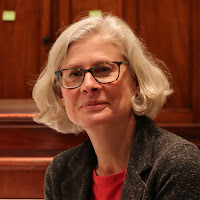 |
| Matthew Parker, Archbishop of Canterbury. 1504-1575 His outstanding collection of Anglo-Saxon manuscripts and other rare volumes became the Parker Library housed in Corpus Christi, Cambridge. |
On Saturday last I Zoomed in to St Edmund’s Cathedral, Bury, the Zoom hosts, AND Corpus Christi College, Cambridge, to join around 200 people to listen to illustrated talks on various aspects of the famous Bury Bible, now kept at Corpus Christi in the Parker Library. We heard wonderfully detailed commentary and insight into this large format Bible, created in Bury St Edmunds Abbey in 1130, although it is estimated that the considerable task took around two years to complete. It is in Latin Vulgate, the standard text in Europe at that time, and is an important example of Romanesque illumination from Norman England, bearing comparison with other famous monumental bibles such as the Dover Bible, [also kept in the Parker Library], Lambeth Bible, Rochester Bible and the Winchester Bible.
 |
| The Bury Bible. |
The Bury Bible is a hand-written and lavishly illustrated bible of the type used in England before the Reformation. It was originally bound in two volumes of great size, each page measuring 52.5cms by 35cms which represented the ultimate double page size possible to create from one whole calfskin. The entire original Bible will have used about 350 skins in total.
 |
| Edward Cheese, Conservator of Manuscripts. who spoke on parchment. |
 |
| Suzanne Reynolds who spoke on 500 years of illustrated manuscripts in the Fitzwilliam with reference to the Bury Bible. |
 |
| Paola Ricciardi who spoke on the study of artists' materials and techniques. |
 |
| An illustration from the Bury Bible. |
 |
| Baldwin, a French monk was appointed Abbot in 1065 and became physician to Edward the Confessor and William 1. |
 |
| 1100 Bury St Edmunds Abbey at the height of its powers. |
leadership by Baldwin, the reforming Norman French abbot who had skilfully garnered the wealth engendered by the gift of Edward the Confessor conferring the right for the Abbey to rule West Suffolk on behalf of the Crown and retain the income such a privilege brought. By 1100 Bury Abbey was one of the largest and wealthiest of English religious houses. In 1046 there were no fewer than 51 books in the Scriptorium, impressive by early mediaeval standards, and book production with, increasingly, illustration in-house, was stronglyT
encouraged by the 1080s arrival of monks from Bec, in Normandy. Anselm became Abbott in 1121 when the Scriptorium was expanded bringing a major advance in book production. During his tenure, until 1148] it was considered essential for a well-run
 |
| A striking image from the Bury Bible. |
 |
| The Bury Bible |
 |
| Illuminated initial from the Bury Bible. |
The idea for the Bible came from Hervey, the Sacrist brother of Prior Talbot of the Abbey and he, Hervey, funded this prestigious enterprise. The history of the Bury Abbey, the Gesta Sacristarum states: “This Hervey, brother of Prior Talbot, met all the expenses for his brother the Prior to have a great bible written, and he had it incomparably illuminated by Master Hugo. Because he could not find calf skins that suited him in our region, he procured parchments in Scotia.”
 |
| 12th century painters/illuminators depicted in the Bury Bible. |
originality, clearly under Byzantine and Greek influence. One of the Corpus Christi speakers, Paola Ricciardi, highlighted a doodle on one page showing a sketch of the head of St Edmund in the margin, uttering the words, “Hic! Hic! Hic! [Here! Here! Here!], the supposed cries from the severed head of St Edmund to the wolf who located him in legend. This would have been scribbled in during some repair subsequent to the Bible’s creation in 1130. She also identified tiny holes on one illustration which she said confirmed that certain special illuminations had been protected originally by a tiny silk curtain covering each.
 |
| Another tiny hole, identified by Paula Ricciardi. Perhaps, wear and tear, showing page below. |





No comments:
Post a Comment